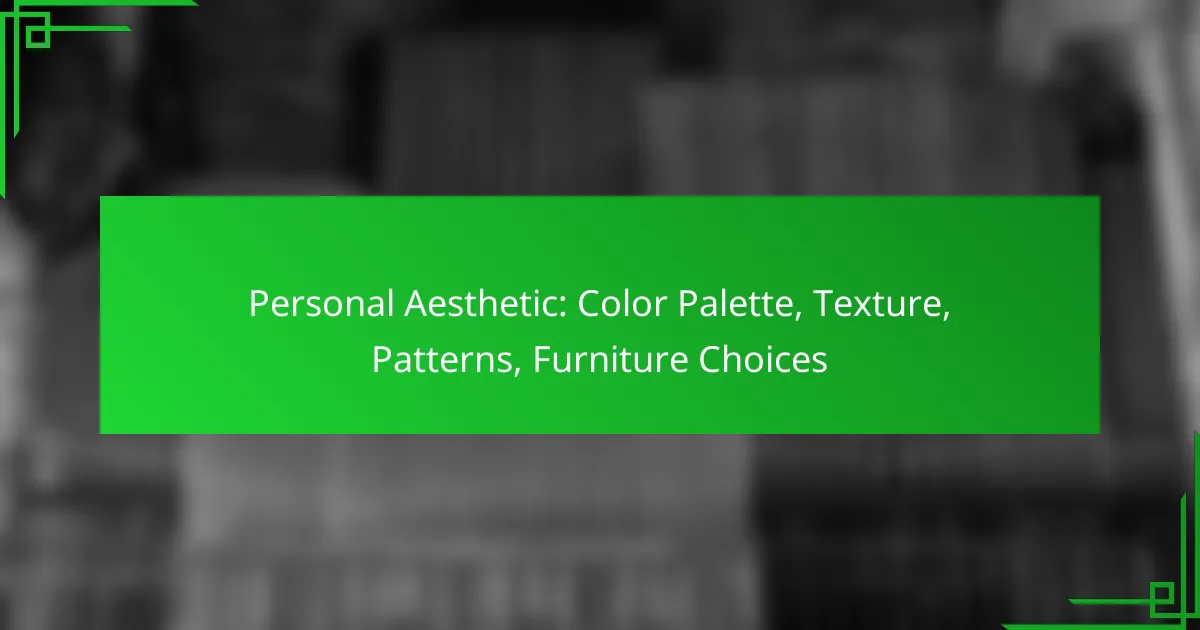Creating a personal aesthetic for your home involves thoughtfully selecting a color palette, textures, and patterns that resonate with your individual style. By choosing colors that evoke the right emotions and complement your space, you can set the desired atmosphere. Incorporating various textures adds depth and interest, while carefully selected patterns can enhance your overall decor, making your environment uniquely yours.

How to choose a personal color palette for your home
Choosing a personal color palette for your home involves selecting hues that reflect your style and create the desired atmosphere. Consider the emotions different colors evoke and how they interact with your space’s lighting and furnishings.
Warm and cool color schemes
Warm color schemes include reds, oranges, and yellows, which can create a cozy and inviting atmosphere. Cool colors like blues, greens, and purples tend to evoke calmness and serenity. When choosing between warm and cool tones, think about the mood you want to establish in each room.
For example, a warm palette may work well in social spaces like living rooms, while cool colors can be ideal for bedrooms or bathrooms where relaxation is key. Mixing warm and cool colors can also create balance, but be mindful of the overall harmony in your design.
Neutral vs. bold colors
Neutral colors such as whites, grays, and beiges provide a versatile backdrop that can adapt to various styles and decor. They allow for easy integration of bold colors through accents like furniture or artwork. Bold colors, on the other hand, can make a strong statement and bring energy to a space.
When using bold colors, consider limiting them to one or two focal points to avoid overwhelming the room. A common approach is to pair a bold accent wall with neutral furnishings to create a striking yet balanced look.
Popular color palette tools
Several tools can help you create and visualize your color palette. Online color generators like Adobe Color or Coolors allow you to experiment with different combinations and see how they work together. These tools often provide options for warm, cool, neutral, and bold palettes.
Additionally, paint companies often offer apps that let you upload a photo of your room and apply different colors to see how they would look in your space. This can be particularly useful for making final decisions before committing to paint or decor purchases.

What textures enhance personal aesthetics?
Textures play a crucial role in enhancing personal aesthetics by adding depth and interest to a space. Incorporating a variety of textures can create a balanced and inviting environment, making it essential to consider how different materials interact with each other.
Natural textures: wood and stone
Natural textures like wood and stone bring an organic feel to interiors, promoting warmth and authenticity. Wood can range from light pine to dark mahogany, while stone options include granite, marble, and slate, each offering unique visual and tactile qualities.
When selecting natural textures, consider the finish and grain patterns. For example, reclaimed wood provides a rustic charm, while polished stone surfaces can add a touch of elegance. Aim for a mix of these materials to create visual contrast and enhance the overall aesthetic.
Soft textures: fabrics and upholstery
Soft textures, such as fabrics and upholstery, contribute comfort and coziness to personal spaces. Common materials include cotton, linen, velvet, and leather, each offering different levels of softness and durability.
Incorporate various fabric textures through cushions, throws, and upholstered furniture to create a layered look. For instance, pairing a plush velvet sofa with linen cushions can add depth and visual interest. Avoid overwhelming a space with too many competing textures; instead, aim for a harmonious balance.

Which patterns work best for personal style?
Patterns that align with your personal style can significantly enhance your space. Choosing the right patterns involves considering your overall aesthetic, the mood you want to create, and how different designs interact with your existing decor.
Geometric patterns for modern decor
Geometric patterns are ideal for modern decor, offering a clean and structured look. They often feature sharp lines and bold shapes, which can create a sense of order and sophistication in a room.
When selecting geometric patterns, consider using them in textiles, wall art, or even furniture upholstery. Opt for monochromatic schemes or contrasting colors to emphasize the design while maintaining a cohesive look.
Common geometric patterns include chevrons, hexagons, and stripes. These can be easily integrated into various elements, such as rugs, curtains, or accent walls, to enhance a contemporary aesthetic.
Floral patterns for a classic touch
Floral patterns add a timeless elegance to any space, making them a popular choice for classic decor. They can evoke a sense of warmth and comfort, often bringing the beauty of nature indoors.
When incorporating floral patterns, consider using softer color palettes to create a serene atmosphere. These patterns work well in fabrics like upholstery, curtains, and bedding, providing a cohesive and inviting look.
Popular floral designs include vintage prints, large blooms, and delicate vines. Mixing floral patterns with solid colors can help balance the visual impact and maintain a sophisticated style.

How to select furniture that matches your aesthetic
Selecting furniture that aligns with your personal aesthetic involves understanding your preferred styles, colors, and materials. Focus on pieces that reflect your taste while ensuring they complement each other and the overall design of your space.
Mid-century modern furniture options
Mid-century modern furniture is characterized by clean lines, organic shapes, and a functional approach. When choosing pieces, look for items made from natural materials like wood, often featuring bold colors or simple patterns.
Consider iconic pieces like the Eames lounge chair or a teak sideboard, which can serve as focal points in your room. Aim for a mix of textures, such as pairing smooth wood with soft fabrics, to create visual interest.
Scandinavian design principles
Scandinavian design emphasizes minimalism, functionality, and a connection to nature. When selecting furniture, prioritize light colors, natural materials, and simple forms that promote a sense of calm and spaciousness.
Incorporate elements like a sleek, white dining table or a cozy, neutral-toned sofa. Avoid clutter by opting for multi-functional furniture, such as storage ottomans or extendable tables, to maintain a clean and organized aesthetic.

What are the latest trends in personal aesthetics?
The latest trends in personal aesthetics focus on creating spaces that reflect individuality through color palettes, textures, and unique furniture choices. Emphasizing personal expression, these trends often blend various styles and elements to create a cohesive yet personalized environment.
Biophilic design elements
Biophilic design incorporates natural elements into interior spaces, promoting a connection to nature. This trend includes using organic materials, natural light, and greenery to enhance well-being and create a calming atmosphere.
Consider integrating plants, water features, or natural wood finishes into your decor. For instance, a living wall or large potted plants can bring life to a room while improving air quality.
Maximalism vs. minimalism
Maximalism and minimalism represent two contrasting approaches to personal aesthetics. Minimalism emphasizes simplicity and functionality, often using a limited color palette and clean lines, while maximalism embraces bold colors, patterns, and an eclectic mix of textures and objects.
When choosing between these styles, consider your lifestyle and preferences. Minimalism may suit those seeking a clutter-free environment, while maximalism can appeal to individuals who enjoy vibrant, layered designs. Aim for a balance that reflects your personality without overwhelming the space.

How to create a cohesive aesthetic in your space
Creating a cohesive aesthetic in your space involves harmonizing color palettes, textures, patterns, and furniture choices. This unity enhances the overall feel and functionality of your environment, making it more inviting and visually appealing.
Color harmony techniques
Color harmony techniques focus on selecting colors that complement each other, creating a unified look. Start with a base color and choose one or two accent colors that enhance it. Tools like color wheels can help identify complementary or analogous colors, which work well together.
Consider using the 60-30-10 rule: allocate 60% of the space to a dominant color, 30% to a secondary color, and 10% to an accent color. This approach provides a balanced and visually pleasing aesthetic. For example, in a living room, you might use a soft gray for walls, a navy sofa, and mustard yellow cushions.
Balancing textures and patterns
Balancing textures and patterns is essential for adding depth and interest to your space. Incorporate a mix of textures, such as smooth, rough, soft, and hard surfaces, to create a dynamic environment. For instance, pair a plush velvet sofa with a sleek glass coffee table and a woven rug.
When it comes to patterns, aim for variety while maintaining cohesion. Use different patterns in similar color schemes to tie them together. A good rule of thumb is to limit the number of distinct patterns to three to avoid visual chaos. For example, you could combine striped curtains, a floral throw pillow, and a geometric area rug, ensuring they share a common color palette.

What are the best e-commerce platforms for home decor?
The best e-commerce platforms for home decor offer a wide range of products, styles, and price points. Key players like Wayfair and West Elm stand out for their unique offerings and user-friendly shopping experiences.
Wayfair for diverse selections
Wayfair is known for its extensive catalog that includes furniture, decor, and home improvement items. With millions of products available, shoppers can find everything from budget-friendly options to high-end pieces, catering to various tastes and preferences.
When using Wayfair, consider filtering by style, price, and customer ratings to streamline your search. The platform often features sales and discounts, making it easier to find deals on popular items.
West Elm for modern furniture
West Elm specializes in modern and contemporary furniture with a focus on sustainable materials. Their curated collections often highlight clean lines and minimalist designs, appealing to those looking to create a chic and stylish home environment.
Shopping at West Elm can be a bit pricier compared to other platforms, but the quality and design often justify the investment. Keep an eye out for seasonal sales and promotions to maximize your budget while shopping for standout pieces.

How to incorporate personal aesthetics into small spaces
Incorporating personal aesthetics into small spaces involves selecting colors, textures, and patterns that reflect your style while maximizing functionality. Focus on cohesive design elements that create a harmonious atmosphere without overwhelming the area.
Color Palette
Choosing the right color palette is crucial for small spaces. Lighter shades can make a room feel larger and more open, while darker hues can add depth and coziness. Consider using a monochromatic scheme with varying tones to maintain visual interest without cluttering the space.
Accent colors can be introduced through accessories like cushions, artwork, or decorative items. Aim for a balance; too many contrasting colors can create chaos, while a well-chosen palette enhances the overall aesthetic.
Texture
Texture adds dimension and warmth to small spaces. Incorporate a mix of materials such as soft fabrics, sleek metals, and natural woods to create a layered look. For instance, a plush throw on a leather sofa can soften the overall appearance.
Be mindful of the scale of textures; oversized patterns can overwhelm a small room. Instead, opt for subtle textures that complement your color palette and enhance the space without dominating it.
Patterns
Patterns can inject personality into small areas but should be used judiciously. Consider using patterned wallpaper or textiles in moderation to avoid visual clutter. Geometric designs can create a modern feel, while floral patterns can add a touch of warmth.
Mixing patterns can work if they share a common color scheme. For example, pairing striped cushions with a floral throw can create a cohesive look, as long as the colors harmonize.
Furniture Choices
Furniture selection is vital in small spaces. Choose multi-functional pieces, such as a sofa bed or an ottoman with storage, to maximize utility without sacrificing style. Keep furniture proportions in mind; opt for slimmer profiles that don’t overwhelm the room.
Arranging furniture to create open pathways can enhance flow. Avoid blocking natural light sources, as this can make the space feel cramped. Consider using mirrors to reflect light and create an illusion of depth.
